With its distinct atmosphere, laid-back culture, warm climate, and hospitable locals, Okinawa offers the perfect backdrop for relaxing and exploring. We called upon fellow travel blogger and Japanese local, Nagisa Tsuchida, to help us round up the top things to do in Okinawa, Japan based on her extensive experience.
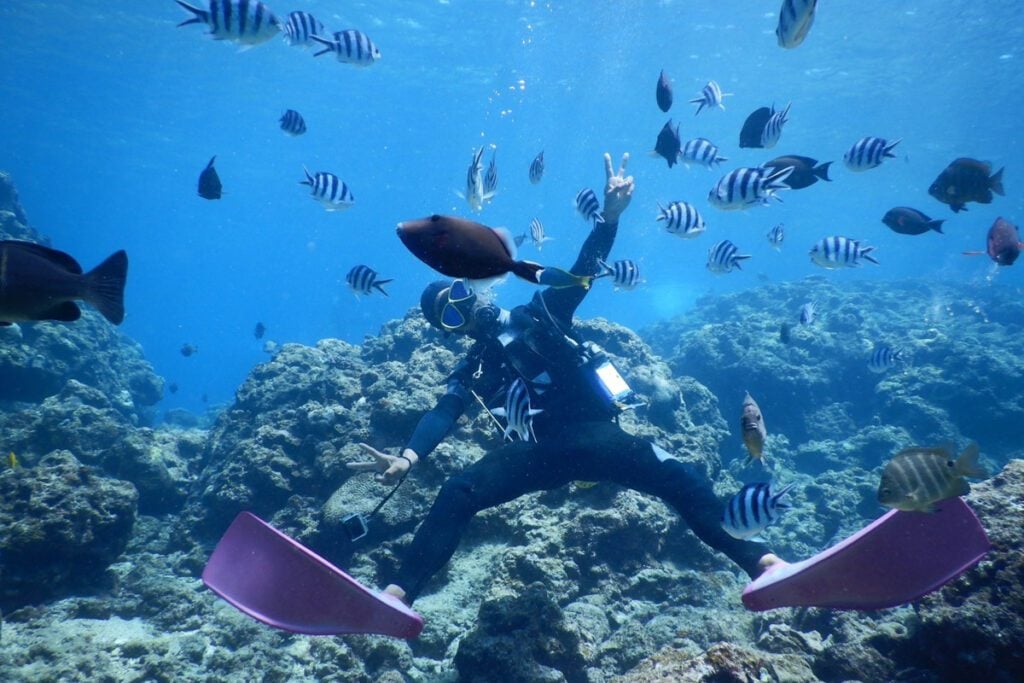
Written by guest author: Nagisa Tsuchida
How about experiencing the renowned longevity of Okinawa, a tropical haven in the southern part of Japan? This southern island prefecture stands out even among Japan’s longevity reputation and also has a very interesting history.
The lush nature, laid-back vibes, friendly locals, perfect weather, and mouthwatering local dishes make it a favorite among tourists as well as Japanese people like myself.
You also have the crystal-clear blue waters, pristine white sand beaches, and vibrant coral reefs that are simply breathtaking. And let’s not forget about the incredible food scene; Okinawan cuisine is a hit all over Japan, and it’s known for fresh, healthy ingredients.
Whenever I set foot in Okinawa, I feel like I’m welcomed with open arms and surrounded by a sense of calm and relaxation.
Picking just a few favorite things to do in Okinawa after ten unforgettable trips from childhood through adulthood is tough, but in this post, I’ll highlight the activities I recommend most for anyone visiting Okinawa.
Okinawa Travel Guide
We broke down the things to do in Okinawa by island so you know exactly how to find what you’re looking for…
- Okinawa Main Island
- Ishigaki Island
- Iriomote Island
- Kuroshima Island
- Kohama Island
- Taketomi Island
- Round up of things to do in Okinawa
For more tips and advice for planning your trip to Okinawa, Japan, jump to the following sections (or just keep scrolling to see it all!).
- How many days do you need
- Best time to visit
- How to get there
- How to get around
- Tips for visiting
- What to eat
- Where to eat
- Where to stay
- What to pack
If you’re planning a trip to Japan, we have the ultimate resource for you!
This FREE PDF download includes everything you’re going to want to pack for your Japan trip, including what NOT to bring, plus tons of insider tips!
Sign up for our ultimate Japan packing list now and get a copy sent straight to your inbox.
Okinawa Main Island
Stretching from north to south, the Okinawa Main Island boasts distinct characteristics across different areas.
In the lush greenery of the north, you’ll find expansive natural landscapes. Moving slightly southward, large resort hotels line the coast, especially in areas perfect for sea activities.
The central region offers a vibrant cultural scene, allowing you to immerse yourself in Okinawa’s unique traditions.
Finally, venturing into the south, you’ll be captivated by the ancient charm of cities influenced by Chinese culture, while also learning poignant reminders of wartime history and messages of peace.
Psst! Okinawa stands out as the only region in Japan without train service, making buses or rental cars the primary modes of transportation. With spots to visit scattered across the island, renting a car is highly recommended for convenience. Check out our Japan car rental guide for everything you need to know!
1. Experience the red symbol of Okinawa, Syuri Castle
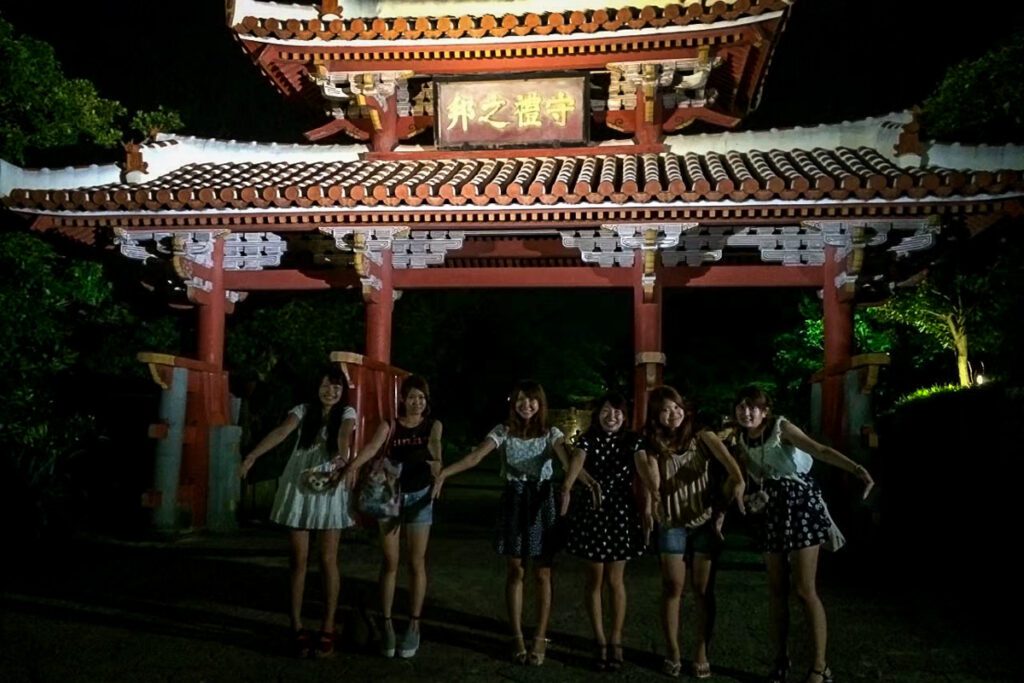
- Opening hours: 8:00 a.m. to 6:30 p.m.
- Entrance Fee Adults: 400 Yen
- Entrance Fee High school Student (16-18 years old): 300 Yen
- Entrance Fee Student (7-15 years old): 160 Yen
Shuri Castle holds a special place in our hearts here in Okinawa. It’s been standing for over 450 years, still shining bright as our symbol. Those vibrant red tiles, pillars, and plaza never fail to captivate us.
Why red? Well, Okinawa gets some of the fiercest sunlight in Japan. The red hue reflects that sunlight, keeping the indoor temperature just right. And it’s not just the castle; you’ll see plenty of homes with red tiles all over Okinawa too.
Beyond the main hall, there are so many other gems to explore. Take the Shureimon gate, for example; it’s even featured on Japanese currency. Back in the days of the Ryukyu Kingdom, it was a place to pray for safety before the king ventured out. It’s like our own little shrine.
Sadly, Shuri Castle was destroyed by fire in 2019, but restoration work is underway with the aim of completion by 2026. But, Currently, it’s possible to observe the restoration work in progress. Witnessing the restoration of historical buildings is a rare and valuable experience, offering insight into the techniques used for preservation.
2. Go shopping at Kokusai-dori

One of the main attractions bustling with people in the heart of Okinawa is shopping on Kokusai-dori street. It’s safe to say that most visitors to Okinawa make a stop here, making it one of the most popular tourist spots.
Stretching over 1.6km, this street is lined with Okinawan souvenir shops, restaurants serving local cuisine, cafes, nightclubs, hotels, and more. It’s like a condensed version of Okinawa all in one place.
3. Visit the Churaumi Aquarium, one of the most famous aquariums in Japan

- Opening hours: 8:30 a.m. to 8:30 p.m.
- Entrance Fee Adults: 2180 Yen
- Entrance Fee High school Student (16-18 years old): 1440 Yen
- Entrance Fee Student (7-15 years old): 710 Yen
The Okinawa Churaumi Aquarium, globally renowned and ranked 9th in the world, is a must-visit spot.
One of its star attractions is the massive tank, stretching 35 meters wide, home to majestic whale sharks and graceful manta rays, truly a sight to behold. With around 16,000 fish of various species, there’s so much to explore.
Insider tip: Don’t miss the “Kuroshio Exploration”, where you can watch whale sharks from above. Seeing them eagerly chow down during feeding times is a great time to see their full awesomeness.
But the excitement doesn’t end there, you can also observe the whale sharks from below, feeling like you’re part of their underwater world.
The “Coral Sea” tank is also amazing. It’s like stepping into a natural paradise, with sunlight streaming down and 80 species of coral to admire.
Plus, watching dolphins up close and enjoying hands-on experiences, both for free, adds an extra layer of excitement to your visit.
4. Go canoeing through mangroves

- Fee Adults (16 and up)(90 minutes riding): About 4000 Yen
- Fee Student (7-15 years old): About 2500 Yen
Mangroves hold a special place in my heart, thriving in the unique blend of freshwater and seawater found only in select areas of Okinawa and neighboring Kagoshima. Their sprawling roots, reminiscent of tangled tentacles, are truly remarkable.
One of my top recommendations for an Okinawan adventure is exploring these mangrove forests by canoe. Despite the sweltering summer heat, the shade provided by the trees creates a serene environment, perfect for enjoying the gentle flow of the river while the cool breeze brushes past.
During these excursions, you have the chance to encounter some fascinating creatures that call the mangroves home. I was particularly captivated by the fiddler crab; the sight of the male’s disproportionately large claw in action was simply adorable.
Recommended spots to experience by canoe
- Hija River and Okusha River – Easy Access from the main island city center.
- Keisaji River – A bit farther from the city center, but particularly rich in nature and designated as a natural monument, even within Okinawa.
Besides mainland Okinawa, you can also experience canoeing on Ishigaki Island and Iriomote Island, as I’ll introduce later. Even if you don’t hop in a canoe, you can observe the mangroves up close for free from the boardwalks set up within the mangrove forests.
5. Embrace the majesty of nature at Valley of Gangala
- Opening hours: 9:00 a.m. to 4:00 p.m.
- Entrance Fee Adults (16 and up): 2250 Yen
- Entrance Fee Student (7-15 years old): 1500 Yen
Welcome to this enchanting power spot called Valley of Gangala. Here, amidst a valley carved by the collapse of a limestone cave, lush subtropical trees thrive.
However, access is exclusive to guided tours, so be sure to reserve your spot in advance. While departure times are limited, English tours are also available.
During the tour, you’ll be mesmerized by stalactites hanging like delicate icicles from the ceiling. Some of the larger ones are revered as sacred objects, believed to bestow blessings of fertility.
And then there’s the awe-inspiring 20 meter tall banyan tree towering majestically in the heart of the valley. Its rope-like roots cascading from a height of 20 meters evoke a profound sense of vitality.
6. Go shopping for Okinawan souvenirs at Okashigoten

Something that is very Japanese, is our love for souvenirs. In Japan, it is considered custom to bring back souvenirs for friends, family and even neighbors from a trip.
Bringing something home that you bought at a place you traveled to might not be the most practical at all times, but the memories we can sharish with these items are well worth it, according to most Japanese.
So if you want an authentic thing to do in Okinawa and a very Japanese experience, do not miss a classic souvenir stroll at Okashigoten. Here you can taste the famous purple sweet potato tart for free and find all kinds of Okinawa souvenirs to fill your bags with!
There are six Okashigoten branches throughout Okinawa, so you should not have a hard time finding one to swing by on your travel-path.
An example of a typical Okinawan souvenir is the Chinsuko. I mention more about this sweet in my section about what food to try in Okinawa later in this article.
But we can also buy some souvenirs exclusive to Okinawa at the supermarket very cheaply, like this block of brown sugar.
7. Check out the cliff shaped like an elephant trunk in Cape Manzamo
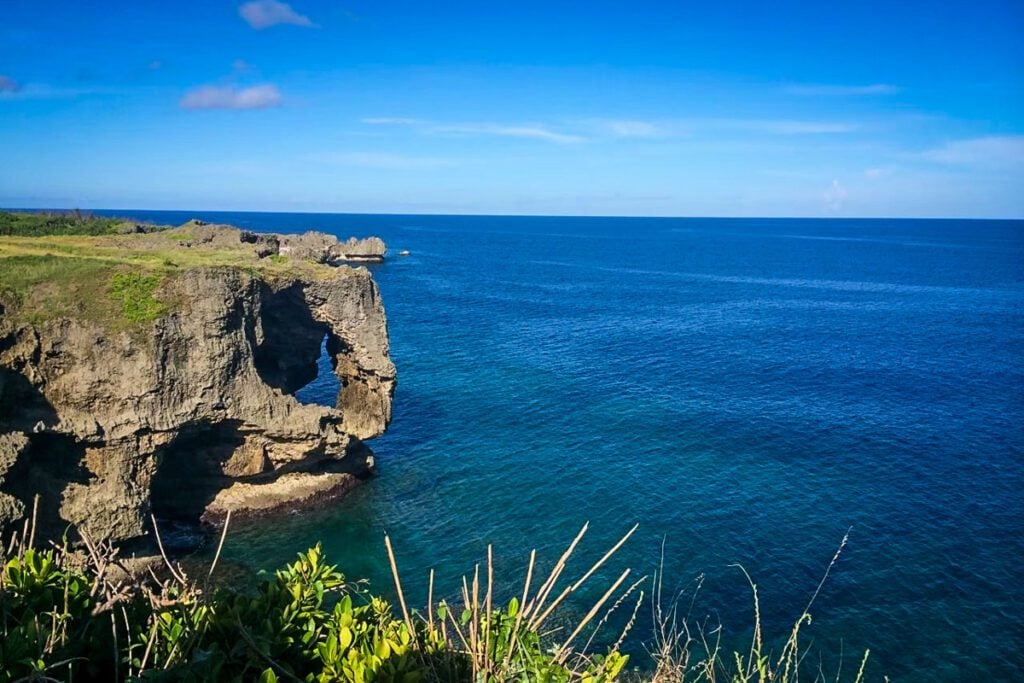
- Opening hours: 8:00 a.m. to 7:00 p.m.
- Entrance Fee (people older than 7 years old): 100 Yen
Located in Okinawa’s resort area, Cape Manzamo is a quintessential scenic spot representing the beauty of Okinawa. Perched atop cliffs, its iconic rock formation resembling an elephant’s trunk overlooks the crystal-clear blue sea and stunning coral reefs visible even from land.
Take a leisurely stroll along the promenade around it, soaking in the mesmerizing views of the shimmering blue sea.
Cape Manzamo is also renowned for its breathtaking sunset views. While the azure sea provides a serene backdrop during the day, at sunset, the sky and sea transform into shades of red, creating a completely different and tranquil ambiance to savor.
8. Learn about war history at Himeyuri Cenotaph
The Himeyuri Monument, erected as a memorial to the Battle of Okinawa during World War II, serves as a solemn site for contemplation, bearing witness to the harrowing experiences endured and prompting reflection on the preciousness of life and the imperative of peace.
The Himeyuri Student Corps, deployed as nursing personnel for the wounded, dedicated themselves tirelessly to their duties, even forgoing rest. Tragically, many lives were lost to gas attacks by the U.S. military, while some individuals chose to end their lives by detonating grenades.
Positioned before caves once utilized as shelters from enemy assaults, this monument stands as a somber sentinel, accompanied by the Peace Memorial Museum nearby, which displays photographs and messages from survivors, serving as a stark reminder of the toll of war and the enduring quest for peace.
9. Try praying in Okinawa’s most sacred place, Sefa-Utaki

- Opening hours: 9:00 a.m. to 5:30 p.m.
- Entrance Fee Adults (16 and up): 300 Yen
- Entrance Fee Student (7-15 years old): 150 Yen
Sefa-Utaki, designated as a UNESCO World Cultural Heritage site, holds immense sacred significance akin to shrines and temples found throughout Japan. However, unlike these sites, it lacks typical structures like torii gates and halls, distinguishing it as a unique spiritual landmark.
As one of Okinawa’s most revered Gutuk (Utaki), Sefa-Utaki stands as an exceptionally sacred site for prayer, believed to house divine spirits within its dense foliage and towering trees, deserving utmost reverence.
Caution must be exercised within the Gutuk, as certain areas are off-limits. Moreover, with the entrance approximately 500 meters away and steep slopes and stairs present, entry with wheelchairs or strollers is unfortunately not feasible.
Entry is also restricted for those wearing excessively revealing attire. Do not wear clothing revealing stomach, shoulder or knees like mini-skirts, tank-tops or short-pants.
10. Make a beautiful creation from Ryukyu glass

Ryukyu glass, a treasure among Okinawa’s traditional crafts. Those trapped air bubbles within the glass? They’re the secret ingredient, adding that extra touch of character to every piece.
I had the pleasure of getting hands-on with Ryukyu glass, at a place called Ryukyu Glass Village on Okinawa’s main Island. I crafted my very own photo frame after some short guidance from an instructor that was available without any type of booking beforehand.
Sorting through a kaleidoscope of glass fragments, each one a different color, shape, and size, I pieced together something truly unique. I think it cost around 800 yen a decade ago, but the memories I made? Priceless.
But that’s not all, there are experiences to be had crafting glass cups, keychains, and lamps too.
11. Try your hand at crafting Shisa, Guardians of Okinawa

As you wander through Okinawa, the presence of Shisa, lion-like guardians perched on rooftops and by entrances, captures the imagination. These mythical creatures serve as Okinawa’s protectors, keeping evil spirits and calamities at bay.
For around 3,000 yen, you have the unique opportunity to craft your own Shisa from clay, a hands-on experience that lets you bring a piece of Okinawan magic home. Additionally, there’s the option to paint pre-made Shisa, infusing them with your personal flair.
Available across Okinawa Main Island and Ishigaki Island, for example Maimai Shisa or for an option closer to Okinawa’s main city Shisa Tsukuri. These crafting sessions can be booked on the same day, offering a creative respite on the unexpected rainy days of your visit.
12. Go scuba diving in Minna and Kerama Islands

If you’re looking for an unforgettable diving experience, Okinawa is the place to be, with its year-round warm weather and crystal-clear waters.
This diver’s paradise is home to vibrant coral reefs, schools of tropical fish, and the chance to encounter sea turtles and manta rays.
One highlight is Kabira Bay on Ishigaki Island, where you’re almost guaranteed to swim with manta rays, the odds are as high as 90%! For more details on this and other diving adventures in the area and around Japan, check out our guide on scuba diving in Japan.
Another great spot for scuba diving is Minna Island, situated just 1.5 km off the coast of Okinawa Main Island. It takes a mere 15-minute ferry ride to reach and Minna Island is famed for having the most beautiful coral reefs near the main island, drawing in 60,000 visitors a year despite its small population of 40.
Then there’s the Kerama Islands, reachable by a 70 minute ferry or a 40-minute speedboat ride. The Kerama Islands boast some of the world’s clearest waters, with visibility extending beyond 30 meters, allowing for up-close encounters with sea turtles and other friendly marine creatures.
Ishigaki Island (Southern Okinawa)
A popular remote island just a one-hour flight away from Okinawa Main Island. Surrounding Ishigaki Island are several other remote islands, easily accessible by ferry, making island hopping a breeze.
Staying on Ishigaki Island and exploring the surrounding islands on day trips is highly recommended.
If you’re planning to explore Ishigaki Island by bus, trust me, getting a bus pass is the way to go.
Hot tip: I can’t recommend it enough, the unlimited ride pass is a steal! For just 1000 yen a day or 2000 yen for five days, it’s a no-brainer, especially when you consider that a one-way bus trip from Ishigaki Airport to downtown costs 540 yen.
You can easily grab one either at the ticket counter or when you hop on board. Plus, the timetable they give you at the counter is a lifesaver, and the buses always run right on schedule.
13. Take in the views at Hirakubosaki
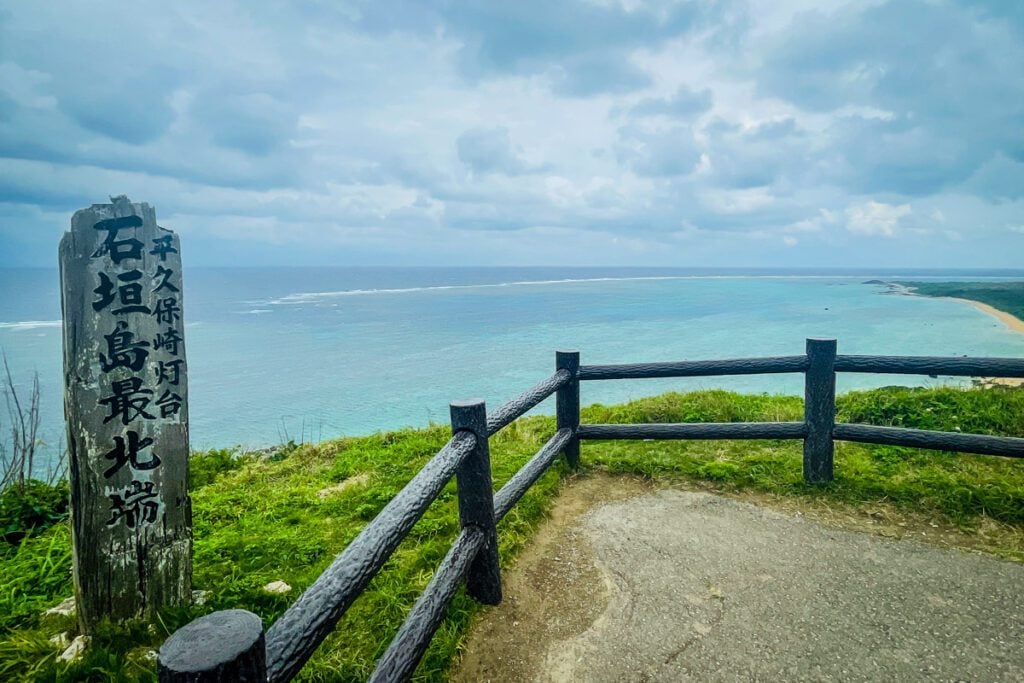
- Travel time from Ishigaki main city by bus: 1.5 hour
The bus service isn’t frequent, so be prepared for a bit of a walk, around 20 minutes from the nearest bus stop, and you’ll arrive at Hirakubo Cape.
Here, you’ll be treated to stunning views of azure coral reefs and a white lighthouse against the backdrop of the horizon. The way the light plays on the water transforms the seascape, leaving you utterly captivated by the scenery.
When I visited, it was overcast, but still, the ocean looked breathtakingly beautiful.
Insider tip: Nearby, there’s this little gem called Akashi Shokudo, renowned for serving up the tastiest Yaeyama soba, Ishigaki Island’s signature dish.
If you find yourself at Hirakubo Cape, do yourself a favor and swing by Akashi Shokudo. Just a heads up though, they’re only open about three days a week, and they wrap up by 3 p.m., so definitely double-check their hours before heading over.
14. Tour Kabira Bay by boat

- Travel time from Ishigaki main city by bus: 50 minutes
Kabira Bay on Ishigaki Island, earning a coveted 3-star rating from the Michelin Green Guide, is truly breathtaking. The emerald green sea here boasts incredible clarity, creating a vibrant habitat for coral and tropical fish.
Taking a glass-bottom boat tour is a must, offering a mesmerizing glimpse into the underwater world.
Even on cloudy days, the sea remains stunning, sparking curiosity about the beauty awaiting on a sunny day.
Insider tip: This area is famous for its high chance of encountering majestic manta rays. Snorkeling offers a thrilling opportunity to witness them for around 10,000 yen, while diving allows for an up-close encounter at around 20,000 yen.
15. Stroll through a palm grove

- Travel time from Ishigaki main city by bus: 1 hour
The Yonehara Palm Grove, home to the unique Yae-yama palm found only on Ishigaki and Iriomote Islands, immerses you in a jungle-like ambiance.
These towering palms, reaching over 20 meters high with leaves extending over 4 meters long, create a majestic sight. You can stroll along pathways to get a close-up view of these impressive trees.
It takes about 30 minutes to walk through this landscape. Conveniently, there’s a bus stop nearby, making it a breeze to stop by and explore this unique sight.
16. Drinking and singing together at Izakaya

Imagine this izakaya as your cozy spot in Japan, like your local pub but with that unique Japanese flair. Usagi Izakaya restaurant is a spot where you can chill out with mates, enjoy some drinks, and munch on delicious bites without breaking the bank.
But what sets this place apart? They host live Okinawan folk music gigs, complete with traditional instruments that fill the air with soothing melodies.
And the best part? After the show, everyone gets in on the fun, singing along and sharing laughs over drinks, turning the joint into a lively scene.
At night, they offered two performances daily, and reservations were a must. I remember having to either drop by the place or make a phone call to secure our spot.
Along with the food and drinks, there was an extra charge of about 800 yen, but it was totally worth it for the fantastic time I had.
Iriomote Island (Southern Okinawa)
- Travel time from Ishigaki Island: 45 minutes
Ferry to Iriomote Island fees:
| Person | One way fee | Round trip fee |
| Adult | 2290 Yen | 4420 Yen |
| Child (under 12 years old) | 1170 Yen | 2260 Yen |
Among the many islands of Okinawa, Iriomote Island holds a special place as the second-largest, with vast stretches of lush jungle covering 90% of its landscape, and an impressive 70% designated as a UNESCO World Natural Heritage Site.
Given its size and the array of nighttime activities, I highly recommend opting for an overnight stay rather than just a day trip.
Insider tip: As for transportation, since the bus service is quite limited, I highly suggest securing a rental car in advance. Despite its size, the island has only about three traffic signals, and you won’t need to worry about paying for parking.
However, always remember to drive at a maximum speed of 40km/h to ensure the safety of the wildlife that may venture onto the roads.
17. Join a night tour in the forests of Iriomote
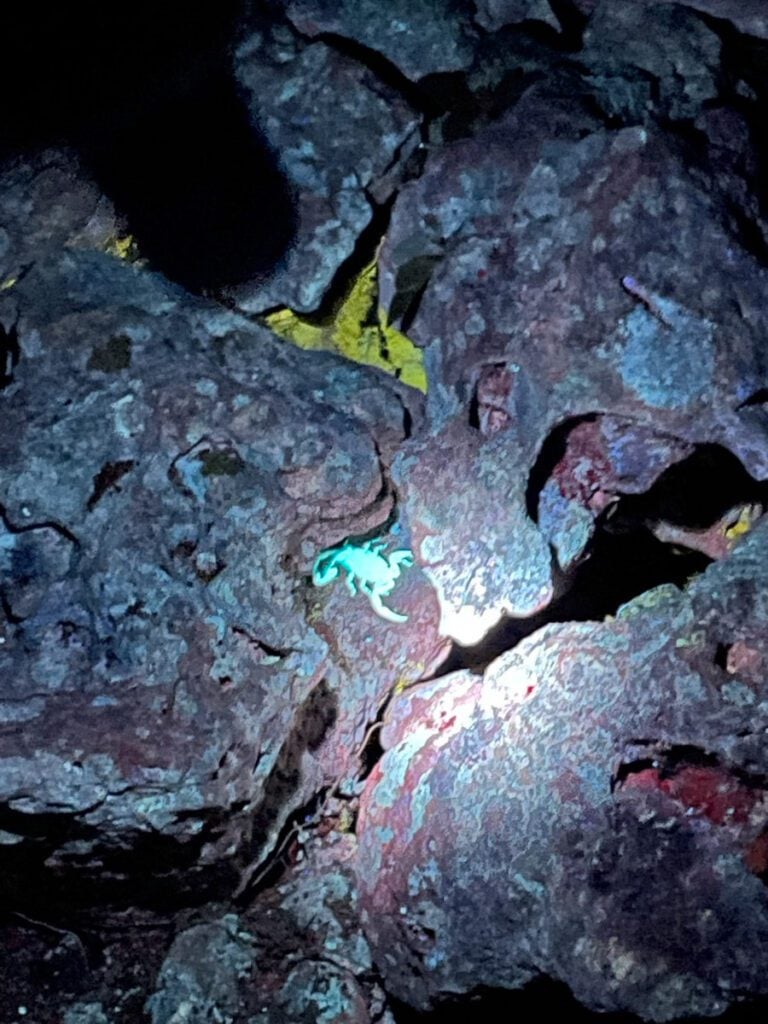

In Iriomote Island, you’ll find a vibrant ecosystem teeming with diverse wildlife, including some rare species. Spotting the endangered Iriomote wildcat is a game of chance, adding excitement to night tours where you can encounter a variety of nocturnal creatures.
You could also get lucky and spot Lightning Scorpions or Ryukyu Scops Owls.
While Asante’s guided tours (website only in Japanese, use Google’s translation feature if you are using a Chrome browser) are priced at 8,000 yen per person, they come highly recommended by locals for their expertise and insight.
During my own nighttime walks, I stumbled upon unexpected encounters like a wild goat resting in the darkness of the trail. The sight of fireflies lighting up the roadside bushes added a touch of enchantment to the island’s allure. It seems the magic of fireflies graces Iriomote Island year-round.
18. Trek to Pinaisarano Falls
At Pinaisara Falls, you can’t miss its majestic cascade, plunging an impressive 54 meters, a sight that commands attention even from afar.
Named for its resemblance to cascading whiskers, this natural wonder offers more than meets the eye.
Embark on a trekking journey nearby, dip into its invigorating pool under the fall, or glide through the mangroves on a canoe.
A bundled adventure package priced at 12,000 yen or more. But rest assured, the experience promises an intimate rendezvous with the wild allure of Iriomote Island.
19. Find sea turtles at Ida beach
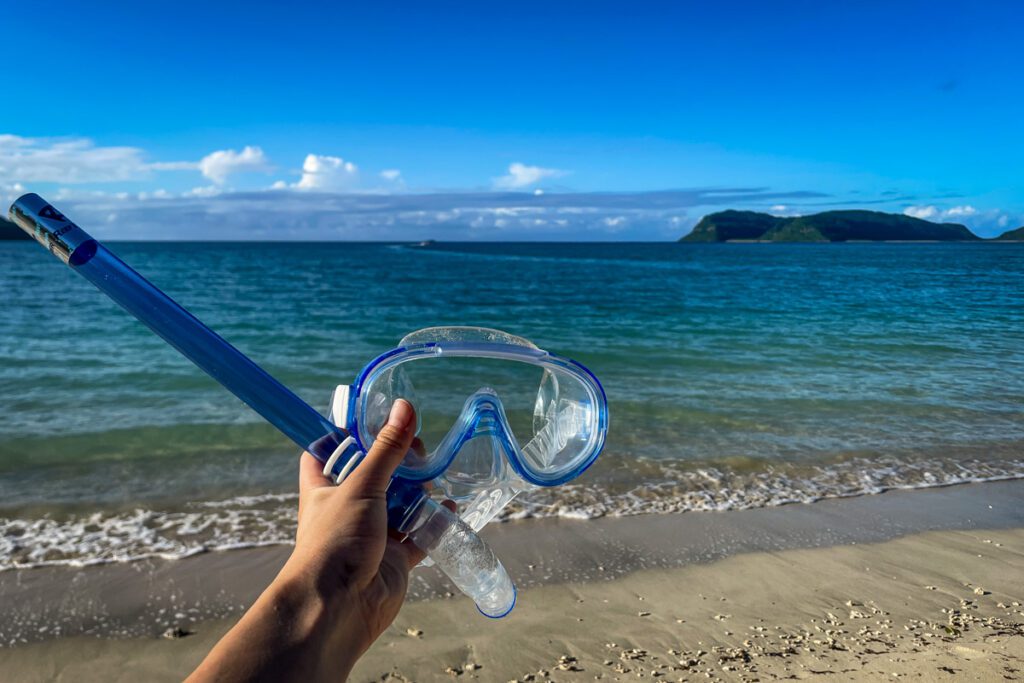
One of the most beautiful beaches on Iriomote Island is Ida-no-hama (ida beach). It takes about 15 minutes by boat to reach there.
This tiny island, home to around 50 people, is like a hidden paradise where you can still experience the old-fashioned way of life. On the way to the beach, I had the chance to observe the islanders’ daily routines.
Guess what? Ida-no-hama Beach is famous for its wild sea turtles!
Even in December, the water was warm enough for a dip. As I swam a little further out, I had an incredible encounter with a sea turtle. It didn’t mind my presence at all, allowing me to swim alongside it in pure delight.
Experiencing such a luxurious encounter with sea turtles for free was truly unforgettable.
20. Take the water buffalo cart to nearby Yufu Island
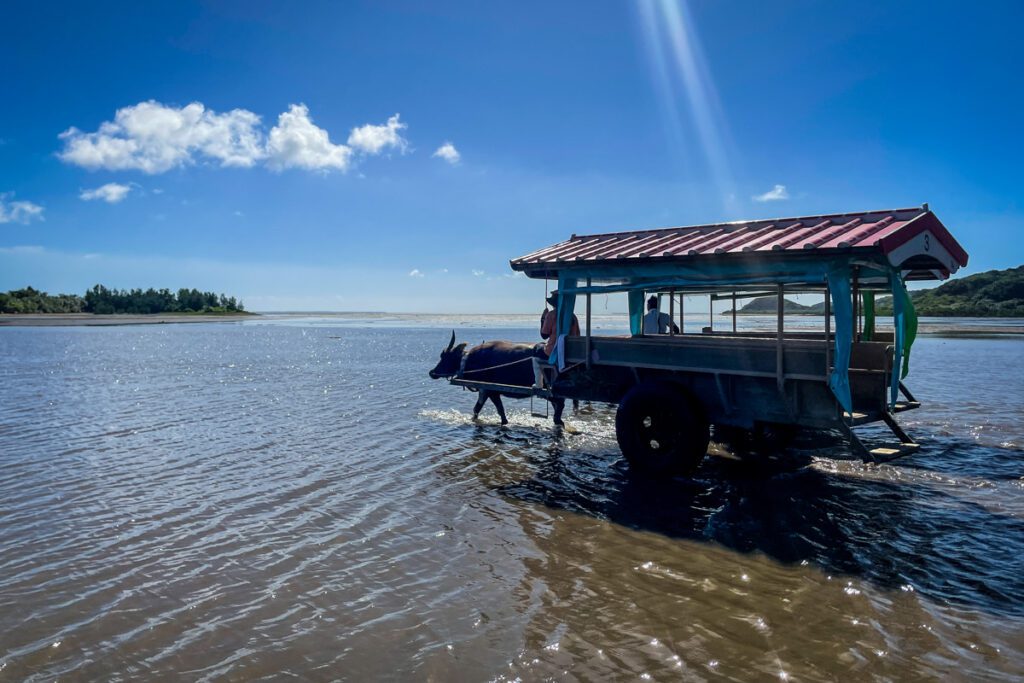
From Iriomote Island, you can reach Yufu Island via a shallow waterway. Instead of walking, you can opt for a distinctive mode of transportation: a water buffalo cart.
Just head to this location on Google Maps to find the water buffalo carts. These carts run approximately every 30 minutes. Payment is settled upon arrival at Yubu Island.

Each cart can carry around 10 passengers and is powered solely by the strength of a single water buffalo.
The journey lasts about 15 minutes, during which the carter, a quintessential figure in Okinawa, serenades us with traditional songs while playing a local instrument. It’s a delightfully laid-back experience.
21. Visit the Bougenvillia Botanical Garden
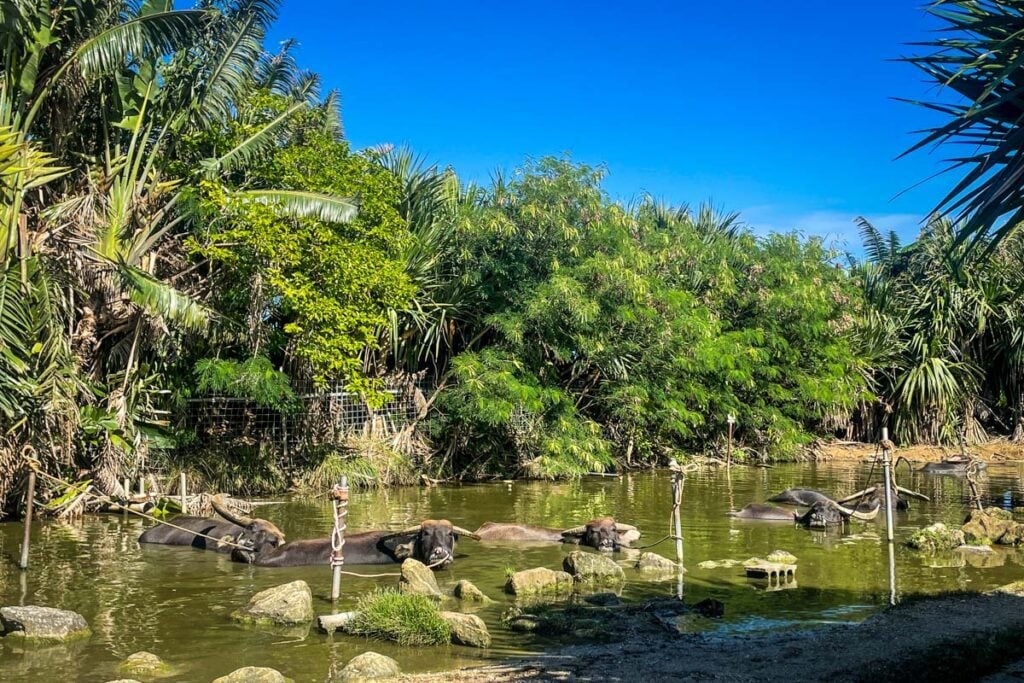
The water buffalo cart ride includes entry to the Bougenvillia Botanical Garden on Yufu Island.
At the entrance, you’ll be greeted by a charming sight: many water buffaloes lounging by the pond, enjoying their bath and rest.
Inside the garden, have a delightful experience capturing photos with the water buffaloes and even petting them. Despite their imposing horns, they exhibit a remarkably gentle demeanor. To top it off, the gardens generously offer complimentary prints of the photos taken together.
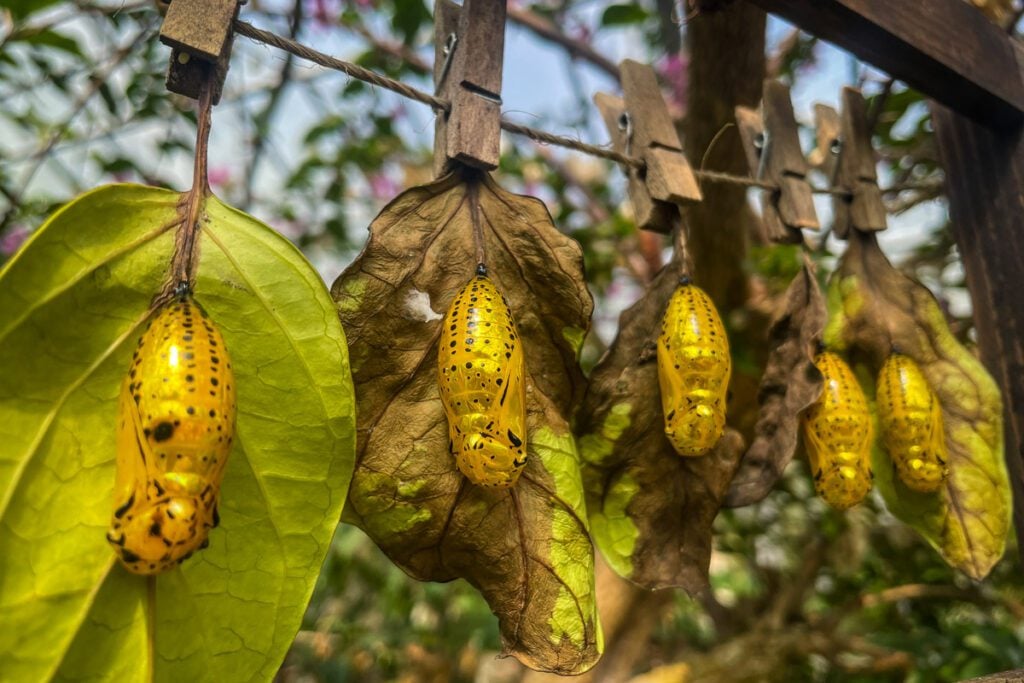

Moreover, you’ll be captivated by the exquisite golden glow of the Great Mormon butterfly chrysalises and have the opportunity to witness them up close, along with the butterflies after they emerge.
The chrysalises shimmered like precious gems, and the adult butterflies showcased stunning black and white patterns on their wings as they gracefully fluttered about.
Kuroshima Island (Southern Okinawa)
- Travel time from Ishigaki Island: 30 minutes
Ferry to Kuroshima Island fees:
| Person | One way fee | Round trip fee |
| Adult | 1680 Yen | 3250 Yen |
| Child (under 12 years old) | 860 Yen | 1660 Yen |
This island is astonishing with over 2000 cows outnumbering its population of about 200 residents. The majority of the islanders are dairy farmers.
Insider tip: Near the harbor, you’ll find cozy neighborhoods, but just a short distance away, the scenery shifts to expansive grasslands.
With no rental cars or taxis available, navigating the island relies solely on bicycles. I chose a rental shop offering bikes at 300 yen per hour. In about three hours, you can fully enjoy a leisurely tour around the 9km island loop.
22. Explore unique Cow-Island
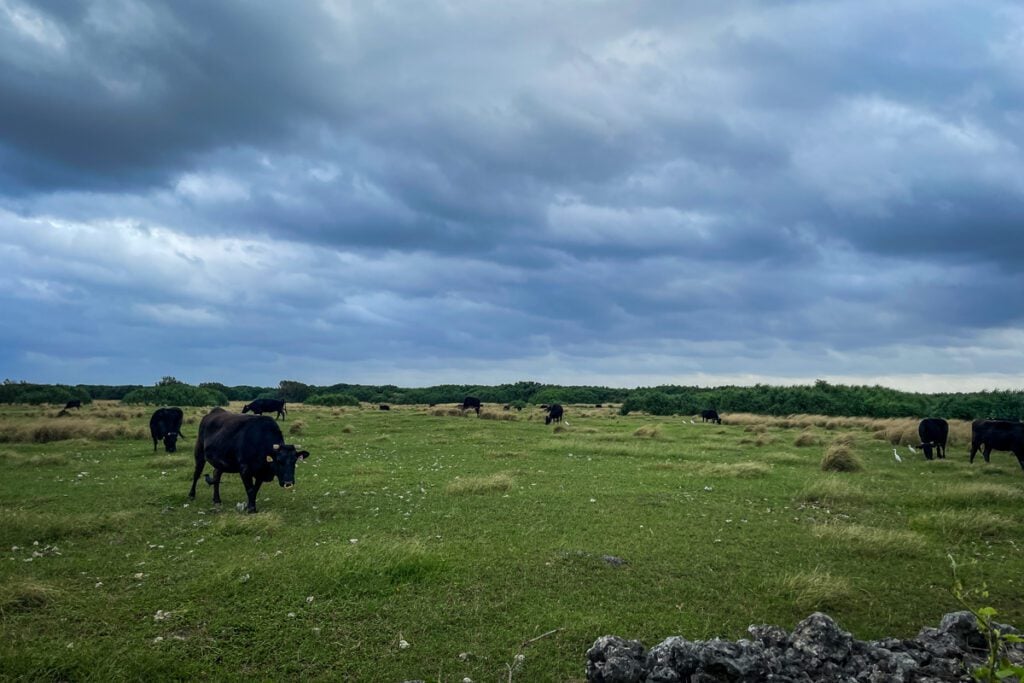
Cycling through the expansive grasslands feels like a personal retreat, offering a serene escape.
Amidst the journey, you’ll cross paths with countless cows, and may not encounter any other people. Witnessing cows grazing or dozing off, their attentive gaze following your every move, can be endearing.
Biking around the quiet neighborhood you’ll find pretty paths inviting you to explore more. When you travel down smaller streets, you’ll find cute Okinawan houses.
It’s all quite new and interesting, even for someone of Japanese descent like myself.
23. Try fried ice cream at Heart Land Café
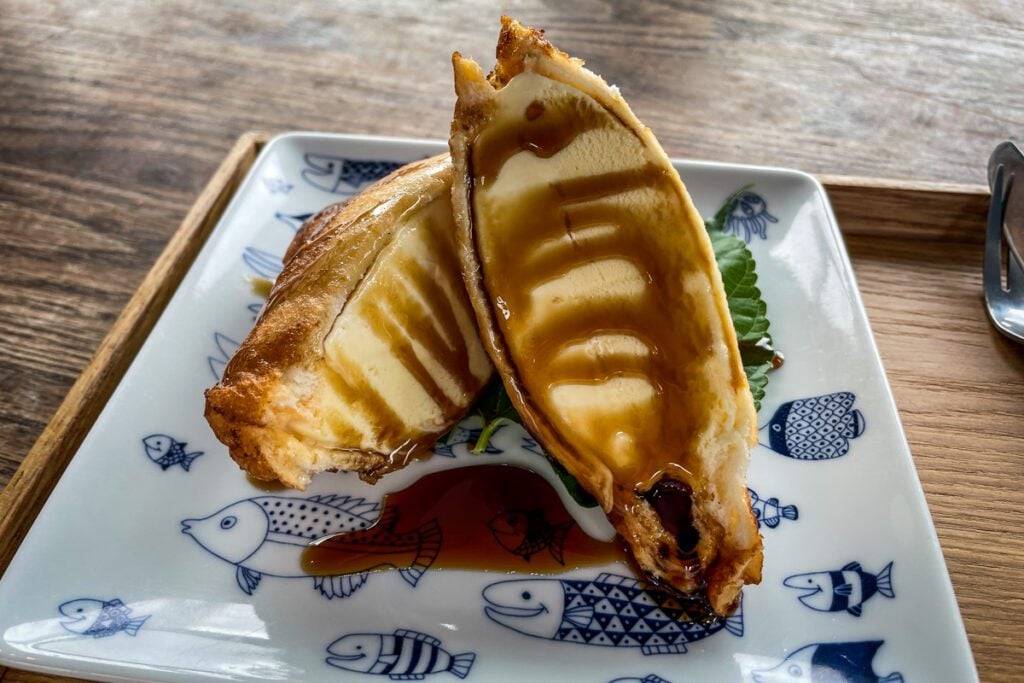
At Heart Land café near the port, they serve a rather unusual dessert. Ever heard of tempura, a popular Japanese dish?
Typically, it involves coating vegetables or sweet potatoes in batter and frying them. But here, they fry ice cream.
Now, you might wonder, wouldn’t the ice cream melt? Surprisingly, the fried ice cream maintains its chilly interior despite its hot, crispy exterior, truly a curious dessert.
Drizzled with black syrup, this dessert is, needless to say, delicious. You can enjoy this intriguing treat for around 800 yen.
Taketomi Island (Southern Okinawa)
- Travel time from Ishigaki Island: 15 minutes
Ferry to Taketomi Island fees:
| Person | One way fee | Round trip fee |
| Adult | 880 Yen | 1700 Yen |
| Child (under 12 years old) | 460 Yen | 890 Yen |
This island, which continues to uphold the ancient traditions of Okinawa, boasts charming streets lined with traditional red-tiled houses.
Rather than feeling like a tourist destination, it exudes the ambiance of a residential area, evoking a very serene atmosphere.
Insider tip: With its circumference of about 9 km, Taketomi Island is best explored by bicycle. Bicycle rentals on Taketomi Island cost around 300 yen per hour. Due to time constraints, I opted for just an hour, but I believe you could comfortably explore for around 2.5 hours.
24. Stroll through town on a water buffalo cart
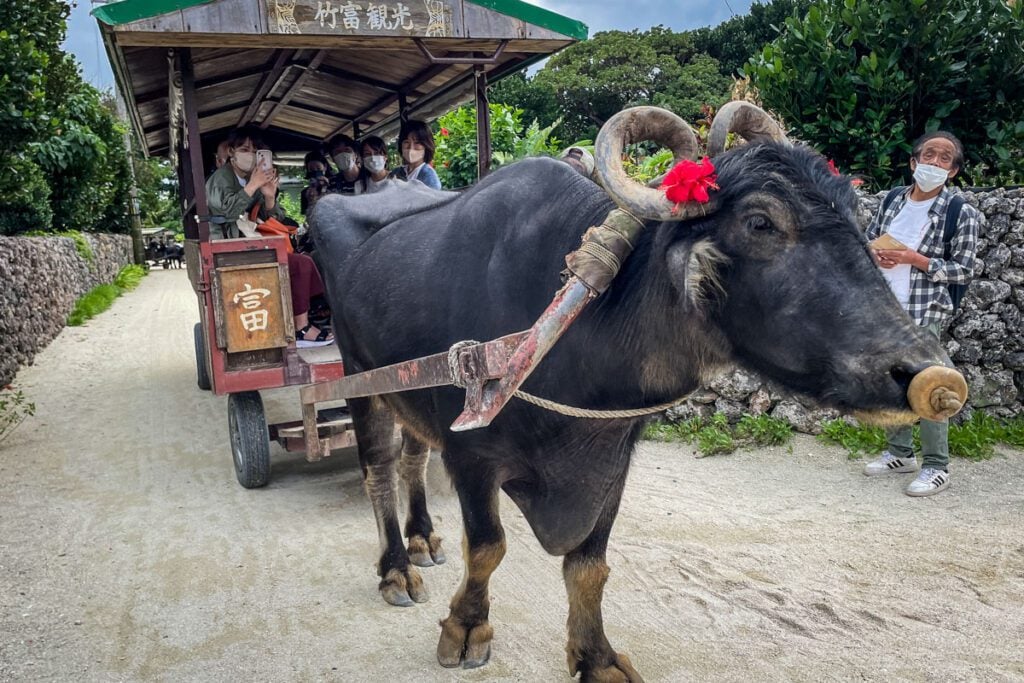
Taketomi Island’s iconic water buffalo carts are a favorite experience for many visitors here.
As I mentioned earlier, while Yubu Island offers rides over water, on Taketomi, it’s a land-based adventure. Riding through sandy pathways, alongside low stone walls, past traditional red-tiled homes, and along charming Okinawan streets on a water buffalo cart is an unforgettable experience.
The cost for a ride, including round-trip ferry fare from Ishigaki Island, was around 4600 yen, with a 10% discount for online bookings.
While exploring the island, you’re sure to come across these picturesque carts, and capturing a photo of one navigating Taketomi’s streets is a truly Instagram-worthy moment.
25. Count stars at Hoshizuna Beach

Hoshizuna Beach has a hidden secret, one of Taketomi Island’s renowned gems. Unlike ordinary shores, here the sands unveil a mesmerizing secret: these grains of sand shaped like twinkling stars!
These aren’t just your average grains of sand but the celestial remnants of tiny marine creatures. Nestled along Okinawa’s pristine coastline, these starry sands are said to grant wishes.

But remember, while you can’t take them home, you can capture their magic in a quaint vial for around 300 yen or adorn yourself with accessories featuring these celestial treasures encased in Ryukyu glass.
Kohama Island (Southern Okinawa)
- Travel time from Ishigaki Island: 30 minutes
Ferry to Kohama Island fees:
| Person | One way fee | Round trip fee |
| Adult | 1560 Yen | 3020 Yen |
| Child (under 12 years old) | 790 Yen | 1520 Yen |
On Kohama Island you can bask in the relaxed island atmosphere, savoring its unique charm while also treating yourself to the luxury of high-end hotels and pristine golf courses, immersing yourself in the full resort experience.
In between, you’ll find vast fields and tranquil mangrove forests lining the coastline, offering a myriad of experiences to enjoy on this enchanting island.
Insider tip: With the island spanning around 17 km in circumference, renting a bike allows you to leisurely explore its wonders. If you opt out of visiting golf courses and hotels, you can still fully enjoy the island’s delights in just 3 to 4 hours.
26. Pedal through sugarcane fields

The heart of Kohama Island is adorned with vast sugarcane fields, which gained nationwide fame in Japan as the backdrop for popular Japanese dramas.
Riding along the straight path that cuts through these fields, known as the “Sugar Road,” with its gentle slopes and declines, spanning 1.3 kilometers, was an experience like no other.
As I pedaled downhill on a rented bicycle, the refreshing breeze against my face was invigorating.
Because of visiting in December when the sugarcane had already been harvested, I couldn’t see the full beauty of the landscape. I’ve heard that during autumn, the fields are a sight to behold, with the lush sugarcane painting a mesmerizing picture.
27. Overlook the entire island at Nishi Ufudaki Observation Deck

In the middle of Kohama Island stands Mount Otake, rising about 100 meters high, with a summit boasting an observation deck providing sweeping views of the entire island.
Though climbing the roughly 300 steps demands effort, the awe-inspiring scenery makes every step to the Nishi Ufudaki Observation Deck worth it.
Encircled by renowned coral reefs, Kohama Island offers breathtaking underwater landscapes.
Even on the cloudy day I visited, the ocean’s allure was undeniable, leaving me eager for a clear day to witness its full majesty.
Watching the sunset from this vantage point is also a cherished experience among visitors.
How many days do you need in Okinawa?
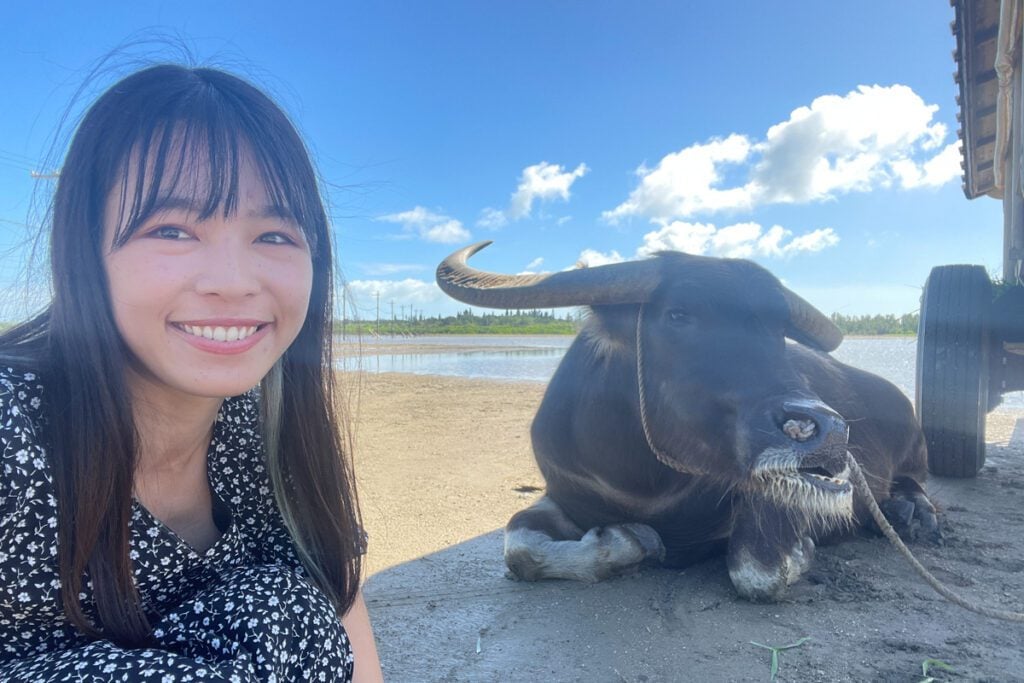
For an ideal trip to Okinawa’s main island, plan to spend at least three days exploring the things to do in Okinawa and culture there.
If you’re extending your visit to include the remote islands around Ishigaki, like Taketomi or Iriomote, aim for a minimum seven days. This longer stay allows for a more relaxed exploration of these smaller islands’ unique charm and natural beauty.
Best time to visit Okinawa, Japan
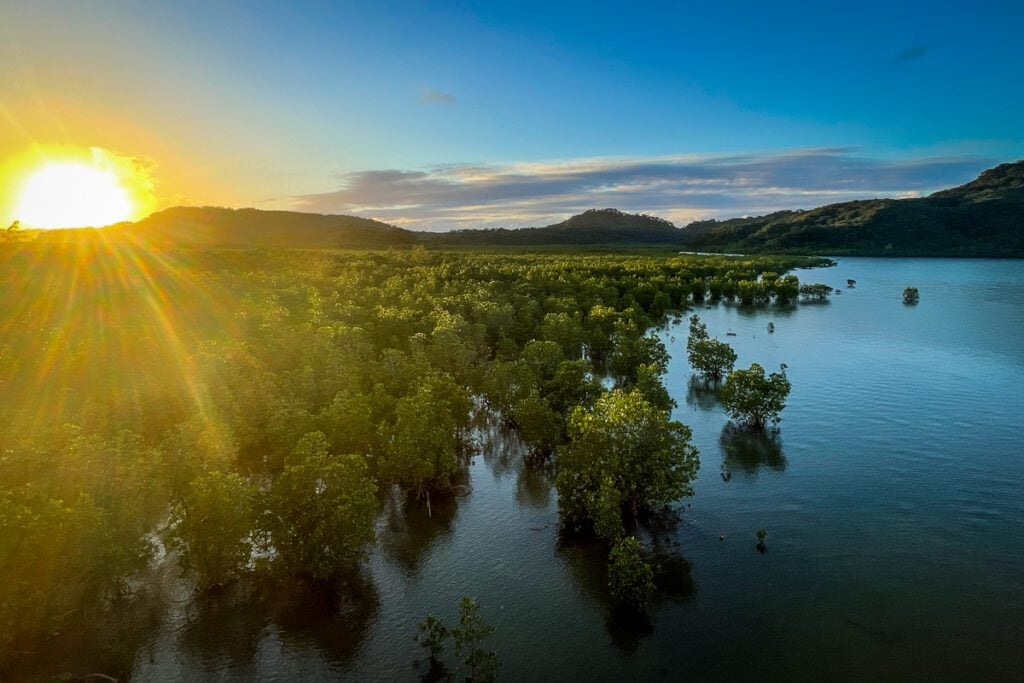
The best time to visit Okinawa, Japan, is from March-June and October, when the island is at its most enjoyable, offering ideal conditions for a variety of ocean activities.
It’s important to note that the months from July to September are peak typhoon season in Okinawa. During this time, typhoons frequently approach the island, potentially leading to flight cancellations and restricted access to beaches.
Planning a trip to Okinawa during these months might involve some uncertainty, and your experience could heavily depend on the weather conditions.
But if you prefer a bit milder climate, Okinawa’s winters are relatively warm with temperatures seldom dropping below 10°C (50°F), ensuring that outdoor activities remain comfortable.
Psst! For an in-depth guide on the seasonal weather patterns and other factors, check out our complete guide on the best time to visit Japan.
How to get to Okinawa, Japan
Okinawa, an island unto itself, stands apart from mainland Japan, reachable only by plane or ferry.
Whether you’re jetting in from Tokyo or Osaka or exploring from other Japanese airports, accessing Okinawa is an adventure in itself, with flights taking around 3 hours from Tokyo and 2 hours from Osaka.
Ferries set sail from Kagoshima Prefecture down south.
And once you’re on Okinawa’s main island, hopping over to Ishigaki and Miyako Islands by air is an option, followed by ferry rides to discover the charm of smaller surrounding isles.
How to get around Okinawa
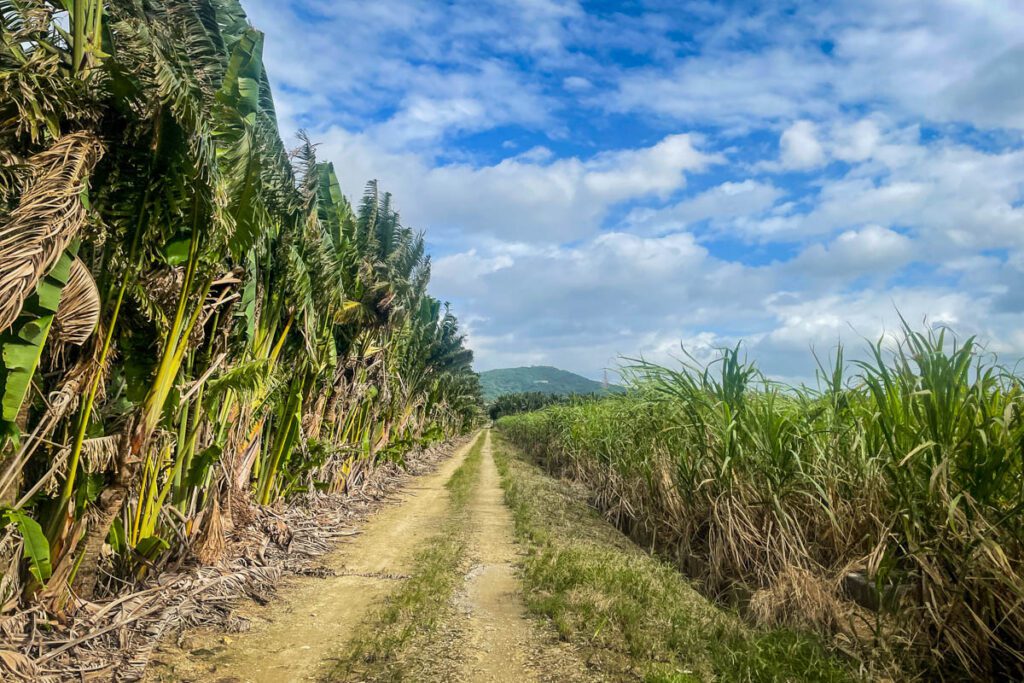
In Okinawa, there is no train, here are the best alternatives to get around Okinawa:
- Renting a car – The main island has highways that allow for shorter travel times, making it particularly convenient for exploring the larger islands like the main island, Ishigaki, and Miyako.
- Renting a motorbike – Riding alongside the beautiful ocean is incredibly refreshing and enjoyable.
- Monorail – Available only on the main island of Okinawa. It offers access to tourist attractions such as Shuri Castle and Kokusai Street from Naha Airport.
- Bus – Their frequency may not be suitable for those with tight schedules.
- Renting a bicycle – Ideal for exploring smaller islands, where taxis and buses may not be available. Plus, riding along narrow paths unique to Okinawa offers a chance for unique discoveries.
Cost for transportation methods:
| Transportation | Single ride / Per hour | 1 day |
| Renting a car | ~4000 Yen | |
| Renting a motorbike | ~4000 Yen | |
| Monorail | ~300 Yen | ~800 Yen |
| Bus | ~200 Yen | ~1000 Yen |
| Renting a bicycle | 300 Yen |
Note: Prices are estimates and may vary depending on duration and distance traveled.
What food to try in Okinawa

In Japan, celebrated for longevity, Okinawa shines with its secret: the local diet. Centered on plant-based ingredients like soy and vegetables, it’s rich in vitamins and minerals yet low in calories.
Okinawan fruits and vegetables are notably high in polyphenols, introducing exotic and healthy options even for those from mainland Japan.
Okinawa’s unique cuisine also reflects its history under American control and proximity to China, blending American and Chinese elements with local flavors. This mix makes a wide range of different foods to try, offering lots of unique dishes.
Especially healthy Okinawan dishes to try
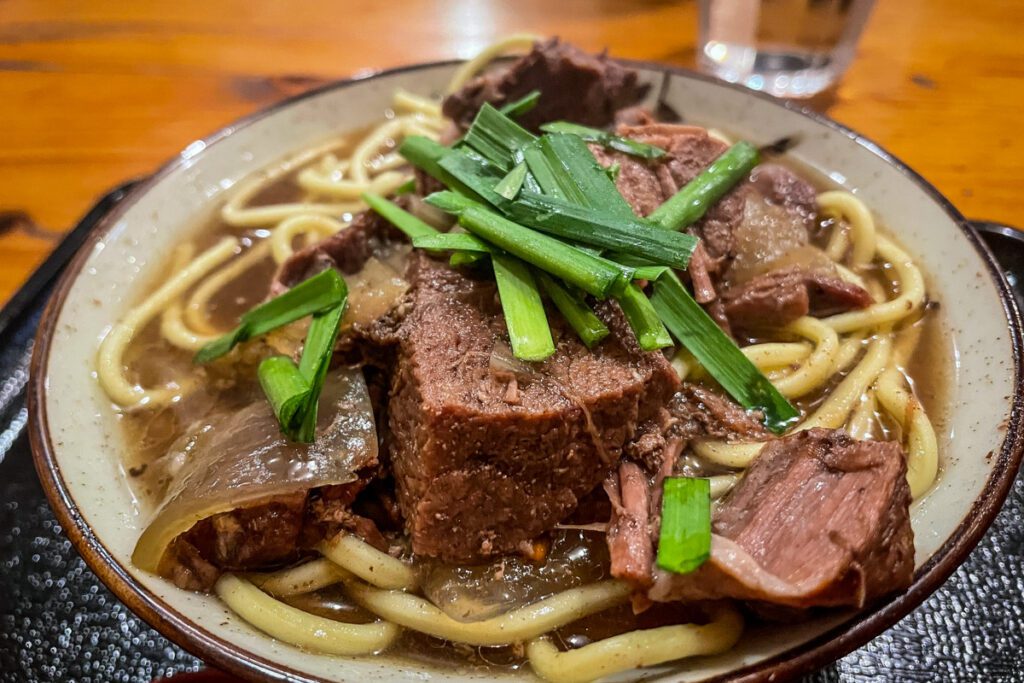
- Island Tofu: High protein food – Tofu is a dietary staple for many, and Okinawa’s island tofu stands out for its high protein content. Its firm texture makes it versatile for various cooking methods, making it a popular choice for health-conscious individuals.
- Goya Champuru: Local cuisine with bitter cucumber – Bitter melon stir-fried with island tofu, pork, eggs, and other ingredients,a beloved local dish often served in diner-style eateries. The bitterness of the melon blends with the sweetness of the vegetables and the richness of the pork, resulting in a truly delicious combination. Bitter melon is rich in vitamin C, making it a perfect dish for combating summer fatigue in the hot climate of Okinawa.
- Jimami Tofu: Made from Peanuts – It is a tantalizing experience to try this peanut-infused tofu, boasting a delightfully chewy yet silky-smooth texture unlike conventional tofu. Drizzled with a subtly sweet sauce, this high-protein, nutrition-packed tofu definitely catches your heart.
Other Okinawan specialities to try

- Okinawa Soba, Yaeyama soba, Soki soba: Original Noodle of Okinawa – There’s quite a variety of renowned noodle dishes, each with its unique style based on the noodle shape and toppings. The flavor changes whether it’s paired with broth infused with pork bones or bonito, or accompanied by seasoned meat. Specialty Yaeyama soba on Ishigaki Island is surprisingly affordable at around 500 yen, yet absolutely delightful.
- Taco rice: Mexican Taco with Japanese rice – Traditional Mexican cuisine with tacos served atop a bed of steamed white rice. Eating it with rice provides a more filling experience compared to tacos alone. Try different restaurants to discover their unique takes on sauces and toppings.
- Rafute: Authentic Okinawan Cuisine – A dish made by simmering thick slices of pork belly with sugar, soy sauce, and sake. It’s perfect for when you crave something hearty, given its rich fat content. The boldly seasoned meat pairs wonderfully with white rice, making it hard to stop eating once you start.
- Umibudo: Seaweed with a Pop of Texture – There is a delightful burst of texture from Okinawa’s popping seaweed, a culinary sensation not to be missed. Surprisingly free of any oceanic scent, its refreshing taste is sure to captivate your palate. Widely available in izakayas and restaurants, it’s also a sought-after souvenir, perfect for bringing a taste of Okinawa home with you.
- Pork and Egg Onigiri (Rice ball): Unconventional Onigiri Delights – This onigiri, a beloved soul food from Okinawa, is a comforting blend of ground luncheon meat and thickly cooked eggs, hugged by rice. Its unique rectangular shape adds to its charm, standing out from the typical triangular ones. You can easily grab one from convenience stores or local bento shops.
- Onisasa: Smashed onigiri (Rice ball) – This is Ishigaki Island’s signature dish. It’s not your typical onigiri where the ingredients are stuffed into rice. Here, they smash together sasami, fried chicken fillet, and rice in a bag, adding mayo or sauce for an extra kick. To try this treat; Go to Chinen Shokai’s Onisasa, well-loved for its unique twists.
Okinawan snacks and sweets

- Chinsuko: Another traditional sweet treat of Okinawa – When it comes to Okinawan souvenirs, chinsuko is my go-to treat. Found in supermarkets and souvenir shops everywhere, it’s known for being both affordable and incredibly tasty. Among the various flavors available, my absolute favorite is the Snow Salt Chinsuko. It’s made with fluffy salt sourced from Okinawa, giving it a unique flavor that’s worth every penny.
- Sata Andagi: Traditional sweet treat of Okinawa – These doughnut-like treats feature a crispy exterior and a chewy, subtly sweet center, priced at around 100 yen each. Sayoko’s Sata Andagi on Ishigaki Island is a popular spot to enjoy these, known for its diverse flavor options and bustling atmosphere. Look for the demon illustration at the entrance and enjoy a variety of freshly made options during your visit.
- Blue Seal: ice cream originating from America – This ice cream, originally from America, offers a variety of about 20 flavors. Among them, the traditional salt chinsuko flavor, a local Okinawan favorite, stands out. You can also find Okinawan sweet potato, shikuwasa, and classic vanilla flavors.
Where to eat in Okinawa
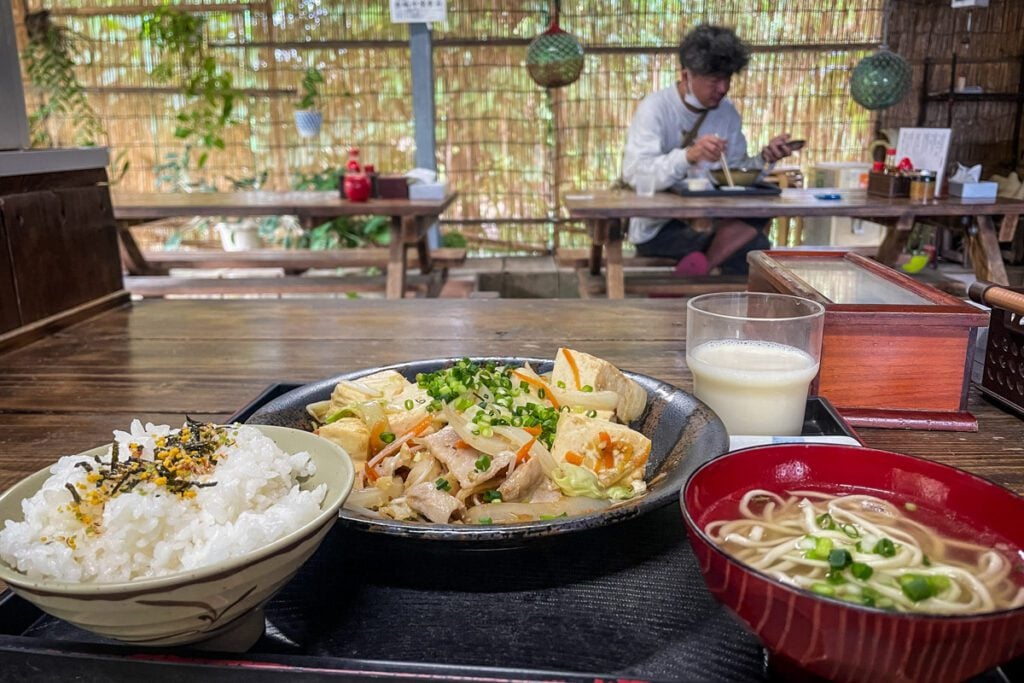
Below are a few of my can’t-miss restaurants and eateries in Okinawa.
Where to eat on Okinawa’s main island
- Nakamura Soba – Near the famed Manzamo Cliff where I introduced #8, there’s a beloved Okinawa soba spot where the soup, infused with seaweed, unleashes the ocean’s aroma upon the first sip. The clear, bonito-flavored broth is light yet rich, offering warmth with each spoonful. Topped with fish cake and sweetly simmered meat, it remains enticing to the very last bite.
- King Tacos – The birthplace of Taco Rice, boasts six locations on Okinawa’s main island. It offers the enticing option of enjoying Taco Rice topped with a generous amount of vegetables for just 700 yen, making it an affordable delight.
Where to eat on Ishigaki Island
- Usagi Izakaya restaurant – The highlight of this izakaya is its live island music, featuring traditional Okinawan instruments. Performances occur twice each night, blending music, meals, and toasts into an unforgettable experience for friends and strangers alike.
- Tofu Higa – Set among sugarcane fields, this quaint restaurant is celebrated for its island tofu, ranked among Japan’s top 100 set meal spots. Guests can savor freshly made tofu with white rice, soy milk drinks, and tofu sides at a great value. Its popularity can lead to tofu selling out early in the day.
- Arakawa Shokudo, Nakayoshi Shokudo, Akaishi Syokudo – At about 500 yen a bowl, this soup blends rich depth and light addictiveness, thanks to hours-long simmered pork. Pictured is Arakawa Shokudo’s Yaeyama soba, while Nakayoshi Shokudo, a top 100 restaurant, Akaishi shokudo,where is located near Hirakubosaki, has a very high reputation, rivals it in deliciousness, making choosing all of them a delightful challenge.
- Sayoko’s Sata Andagi – Step into a beloved spot where you can enjoy Sata Andagi, a traditional Okinawan sweet, fresh from the fryer. Priced at around 100 yen each, the variety of flavors on offer changes throughout the day, making every visit a unique treat.
- Chinen Shokai – Renowned for its tasty Onisasa, this spot offers an innovative B-grade gourmet delight: smashing chicken tender fry and rice balls in a bag, topped with mayonnaise, a popular and unique way to enjoy this culinary creation.
Where to stay in Okinawa – Highlights
Here are a few hotels I’ve personally stayed at and loved in Okinawa.
Okinawa main Island – Renaissance Okinawa Resort
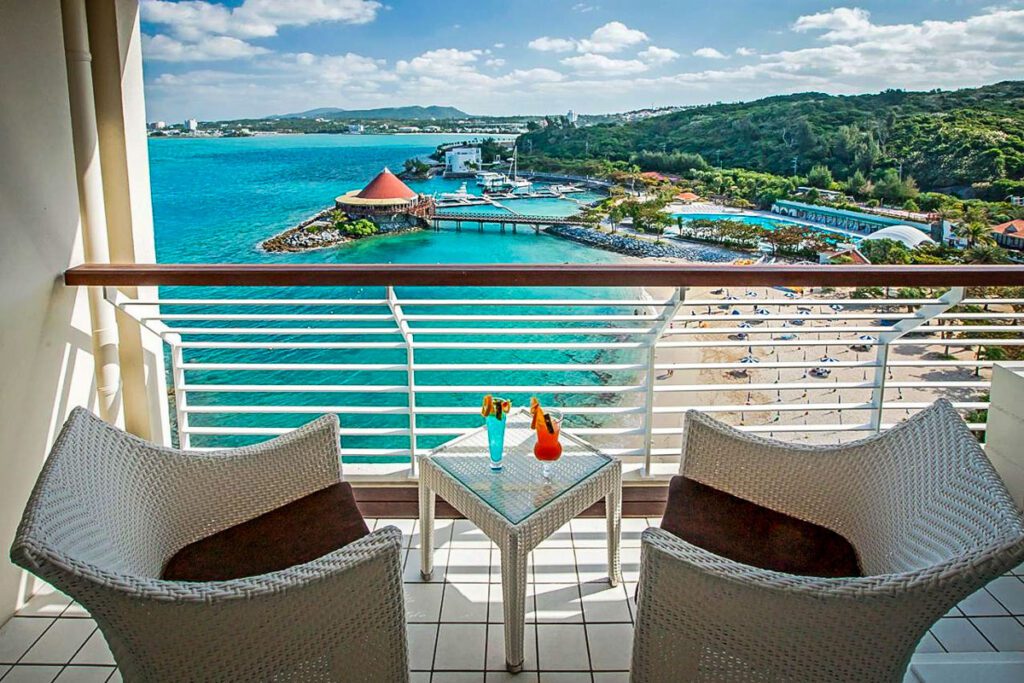
The Renaissance Okinawa Resort is a family paradise nestled in Okinawa, offering close encounters with dolphins and a variety of other creatures. With over 50 marine activities, pools equipped with water slides, job experience programs for kids, and candy-making classes, it’s a treasure trove of activities that promise smiles all around.
While a family of four might invest nearly 100,000 yen for an overnight stay, select rooms enchant with delightful sea-themed designs and bedding that can connect through an interior door, creating a secret haven just for kids. For more standard accommodations, rates start from 13,000 yen per person per night.
An additional major attraction is the complimentary breakfast and dinner for children under 12, making it an alluring choice for memorable family vacations.
Kohama Island – Hotel Haimurubushi

This beach resort, tucked away at the southern tip of Japan within a national park, feels like a hidden gem. From snorkeling in the pristine coral reef waters to paddling under the starry night sky, every moment here is pure magic.
Prices for a night’s stay range from 15,000 to 50,000 yen. And there’s so much more to explore within the resort grounds. Buggy rides, horseback adventures, serene yoga sessions, and lively island music performances are just a taste of what awaits.
As I gazed up at the night sky, I couldn’t help but be mesmerized. Even my phone camera captured its beauty, though nothing beats the awe-inspiring sight seen with your own eyes.
What to pack for your trip to Okinawa, Japan

When visiting popular destinations like Tokyo and Kyoto, you’ll probably be wearing street clothes and comfortable walking shoes. However, in Okinawa, you’ll want to make sure you pack swimwear and your sunnies!
We know it can be overwhelming packing for a trip to a new destination. That’s why we spent hours creating these super helpful guides full of packing hacks and tips for traveling in Japan that you won’t find anywhere else:
- Our Japan packing guide lists all the essentials (many of which you might not think about), as well as what you should NOT pack for a trip to Japan.
- This article on what to wear in Japan will help you create a perfect capsule wardrobe for every season and let you in on some cultural taboos so you can be sure to dress appropriately.
- With this FREE Japan packing list PDF download, we’ll send checklists straight to your inbox for everything from clothing and toiletries (for both women and men!) to what shoes to pack and extra stuff you may want to have on-hand just in case. Click the image below to get your free copy!

Round up of the best things to do in Okinawa
Here’s a recap of all the best things to do in Okinawa, Japan so you can see everything in one place.
- Syuri Castle
- Kokusai-dori street
- Okinawa Churaumi Aquarium
- Canoeing through mangroves
- Valley of Gangala
- Okinawan souvenirs at Okashigoten
- Cape Manzamo
- Sefa-Utaki
- Himeyuri Cenotaph
- Ryukyu glass crafts
- Crafting Shisa
- Scuba diving
- Hirakubosaki
- Kabira Bay
- Palm Grove
- Izakaya
- Iriomote
- Pinaisarano Falls
- Ida beach
- Yufu Island
- Bougenvillia Botanical Garden
- Cow-Island
- Heart Land Café
- Water buffalo carting
- Hoshizuna Beach
- Biking through sugarcane fields
- Nishi Ufudaki Observation Deck

About the guest author
Nagisa Tsuchida is the friendly and passionate travel guide behind girlfromjapan.com. With a lifetime of exploring Japan’s hidden gems and popular spots, she shares her love for her homeland through engaging stories and tips. Her blog is your go-to for discovering Japan from a local’s perspective, from bustling cities to serene villages. Follow Nagisa for an authentic journey through the beauty and diversity of Japan!
More resources for traveling in Japan
We have TONS of resources on travel in Japan and destinations throughout the country. Check out our Ultimate Japan Travel Guide for all the answers to your most burning questions, or read some of our favorite articles below!
- Japan Rail Pass: Where to Buy & Is It Worthwhile?
- Trip to Japan Cost: Tips for Budget Travel in Japan
- Japan Pocket Wifi vs. Japanese SIM Card: Review & Comparison
- Best Japan Travel Apps
- Expert Tips for Visiting Japan (Dos & Don’ts!)
- Ultimate Japan Travel Guide: Everything You Need to Know for Your First Trip to Japan
- Helpful Japanese Words & Phrases to Know for Traveling in Japan
Save this article to Pinterest for later!
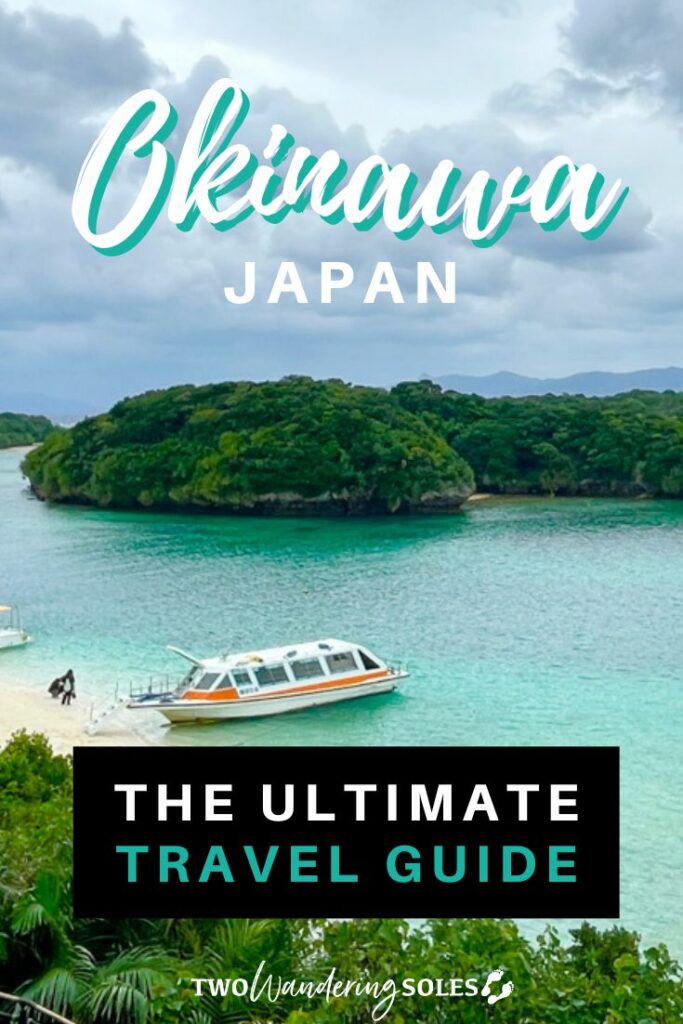
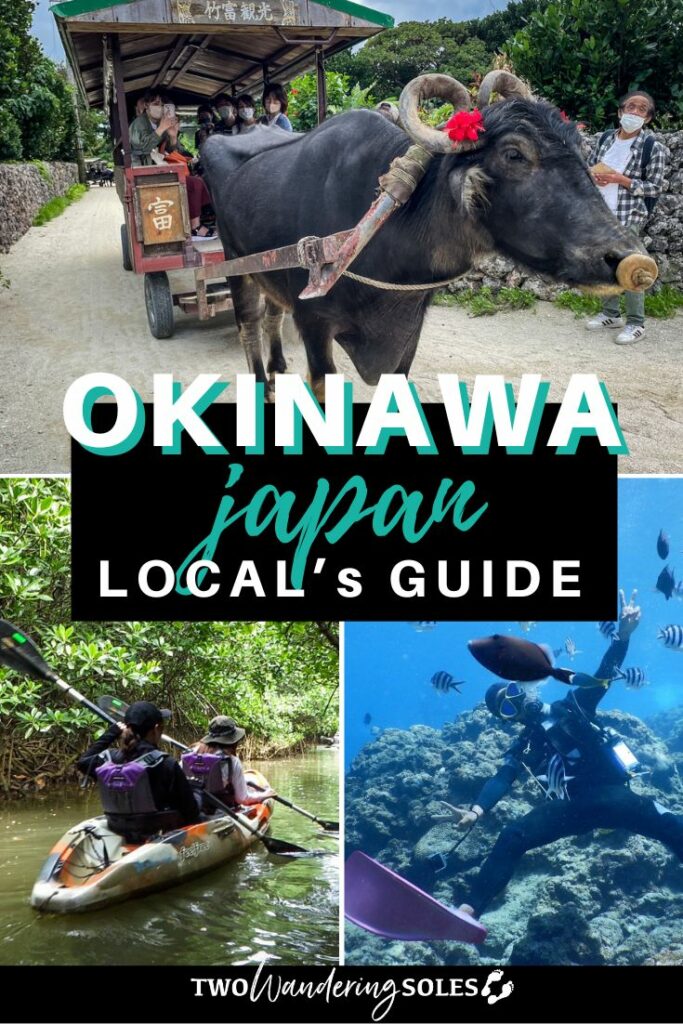
We want to hear from you!
Which of these unique things to do in Okinawa, Japan is going straight to the top of your bucket list? Do you have more questions about traveling to Japan? Leave us a comment below and we’ll do our best to get back to you!

